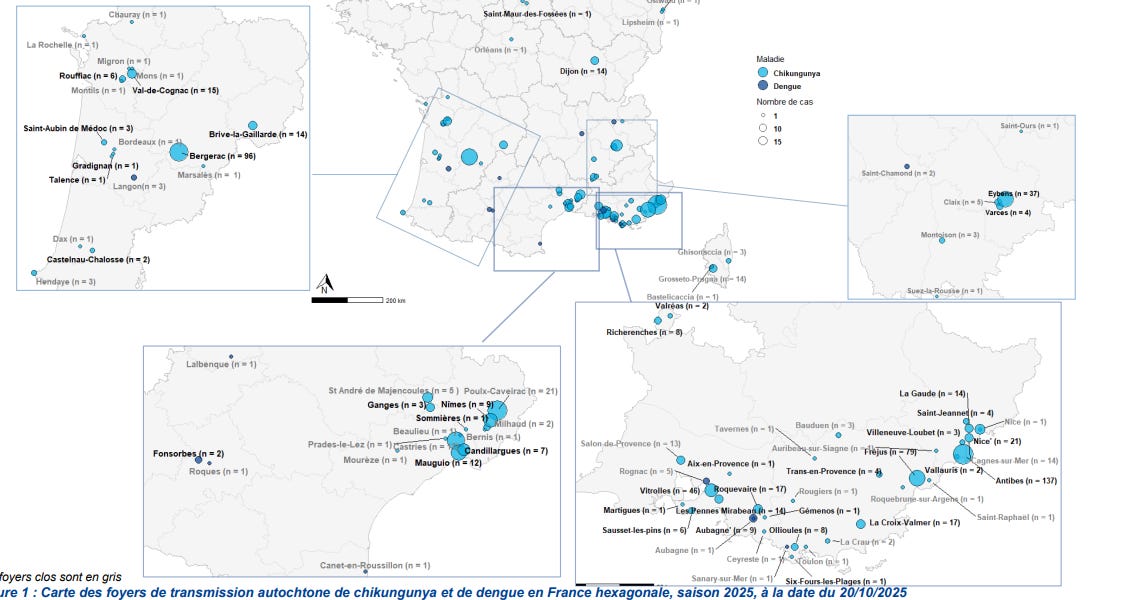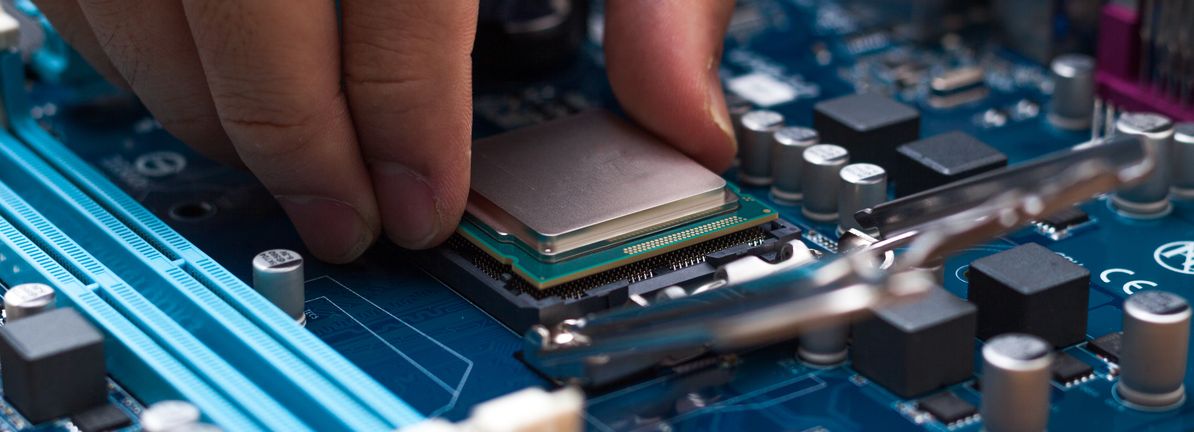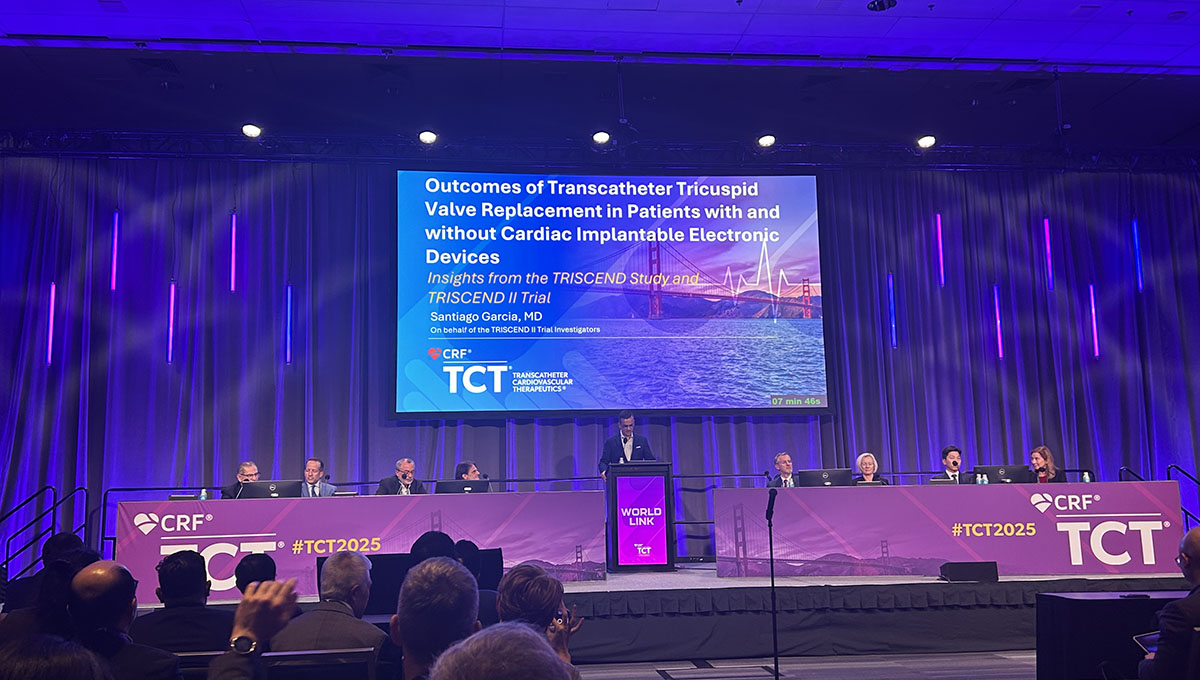Sante publique France reports, as of October 20, 766 locally acquired chikungunya cases were reported in mainland France.
In addition, 29 local transmission of dengue fever have been reported this year.
91 outbreaks of indigenous vector-borne…

Sante publique France reports, as of October 20, 766 locally acquired chikungunya cases were reported in mainland France.
In addition, 29 local transmission of dengue fever have been reported this year.
91 outbreaks of indigenous vector-borne…

Investor sentiment around UP Fintech Holding (NasdaqGS:TIGR) has picked up after UBS and Jefferies each began covering the company with optimistic outlooks. The analysts highlighted the company’s foothold in expanding Hong Kong and Singapore wealth markets as well as its financial momentum.
See our latest analysis for UP Fintech Holding.
The upbeat analyst attention and momentum in Hong Kong and Singapore have helped fuel a stellar run for UP Fintech, with a 53.9% year-to-date share price return and a striking 1-year total shareholder return of 66.1%. Both the recent buzz and the longer-term track record, up 173% over three years, suggest that optimism around the company’s growth story is gaining traction among investors.
If fresh analyst optimism has you rethinking your watchlist, this could be the perfect moment to broaden your investing horizons and discover fast growing stocks with high insider ownership
But with shares already rallying this year and analyst targets suggesting more upside, the question is whether UP Fintech’s impressive growth is still underappreciated or if markets have already accounted for those future gains.
With the latest narrative valuing UP Fintech at $14.12, the gap versus the last close at $10.28 has caught attention. This fair value, calculated using a specific set of forward-looking earnings and margin assumptions, shapes the current debate around where the market might move next.
Strong growth in revenue, assets, and profitability; expansion into high-potential markets; and ongoing tech innovation position UP Fintech for durable, scalable, and diversified earnings.
Read the complete narrative.
Record margins, bold revenue forecasts, and a future earnings multiple are at the heart of this narrative. Want to see what assumptions drive this eye-catching target? The reasoning behind these numbers will surprise you.
Result: Fair Value of $14.12 (UNDERVALUED)
Have a read of the narrative in full and understand what’s behind the forecasts.
However, intensifying regulatory scrutiny and higher client acquisition costs in key markets could disrupt UP Fintech’s strong growth momentum and future profit forecasts.
Find out about the key risks to this UP Fintech Holding narrative.
If you think the numbers tell a different story or want to dig into the details yourself, you can craft your own take on UP Fintech in just a few minutes. Do it your way
A good starting point is our analysis highlighting 4 key rewards investors are optimistic about regarding UP Fintech Holding.

Samsung has announced that it’s secured a partnership with Paris’s famed Centre Pompidou museum that will bring no less than 25 of the gallery’s most famous and revered masterpieces to Samsung’s online digital Art Store, enabling Samsung…

eInfochips, an Arrow Electronics company, and NXP Semiconductors recently announced a multi-year collaboration focusing on software distribution and customer services for NXP’s S32 microcontrollers, aiming to accelerate the development of software-defined vehicles.
This partnership highlights Arrow’s ongoing efforts to expand its value-added engineering and software support capabilities within the automotive and embedded systems sectors.
We’ll examine how Arrow’s expanded role in automotive software solutions with NXP could impact its outlook for recurring, higher-margin services growth.
These 15 companies survived and thrived after COVID and have the right ingredients to survive Trump’s tariffs. Discover why before your portfolio feels the trade war pinch.
To be a shareholder in Arrow Electronics, you must believe that the company can successfully pivot toward higher-margin, recurring revenue streams as industrial, automotive, and connectivity trends drive demand for electronics content. While the recent eInfochips–NXP collaboration underscores Arrow’s ambitions in software and engineering services, it does not materially affect the immediate risk that automation and direct sourcing could weaken Arrow’s position in the traditional distribution business.
The most relevant recent announcement is Arrow’s appointment of an interim CEO in September 2025. This leadership change, closely following strategic partnerships, may impact Arrow’s agility in executing new service-focused initiatives as it aims for greater exposure to the software-defined automotive sector.
However, against this potential for a shift into higher-value offerings, investors should also recognize the risk if digital procurement trends accelerate and…
Read the full narrative on Arrow Electronics (it’s free!)
Arrow Electronics’ outlook suggests $35.2 billion in revenue and $734.1 million in earnings by 2028. This is based on an anticipated 7.3% annual revenue growth and a $266.9 million increase in earnings from the current $467.2 million.
Uncover how Arrow Electronics’ forecasts yield a $116.75 fair value, a 3% downside to its current price.
Two fair value estimates from the Simply Wall St Community both land at US$116.75, reflecting remarkably consistent expectations. Some see Arrow’s effort to expand recurring, engineering-related services as a turning point, but your experience could differ, explore alternative viewpoints to inform your decision.

Japan’s new HTV-X cargo spacecraft launched on its first-ever mission to the International Space Station on Saturday (Oct. 25).

Cipher Mining (CIFR) surged this week as investor enthusiasm around Oracle’s $38 billion data center expansion spilled over into the AI and crypto infrastructure sector. The company is now seeking additional capital through a Google-backed bond deal, a move that underscores its ambitions in AI data centers.
See our latest analysis for Cipher Mining.
Shares of Cipher Mining have been on a tear, notching a 327.74% year-to-date share price return thanks to surging interest in AI infrastructure and several headline-grabbing deals. Momentum is clearly building, with a one-month share price return of 46.11% and Friday’s standout 19.73% jump, even as recent volatility in crypto pushed some peers lower. With a 12-month total shareholder return of 278.39% and a 3-year total return well above 1,600%, both short- and long-term performance underscore just how hot sentiment has become for companies straddling the AI and crypto sectors.
If this surge in AI and crypto infrastructure piques your interest, the next step is to discover See the full list for free.
With shares soaring and bullish headlines fueling excitement, the key question remains: does Cipher Mining still offer room for upside, or is its future growth already fully reflected in today’s prices?
With Cipher Mining recently closing at $20.66, the most popular narrative sees the fair value at $16.88. This suggests the price is running ahead of fundamentals. Here’s what is driving the story at the center of the bullish debate.
“Industry-wide demand for large-scale, flexible, and energy-rich data center sites, driven by accelerating institutional and mainstream adoption of digital assets and AI, aligns with Cipher’s strategy to develop infrastructure that can quickly pivot between Bitcoin mining and high-performance computing (HPC), creating upside potential for both revenue diversification and earnings stability.”
Read the complete narrative.
Want to know what justifies this premium price tag? The narrative is built around extreme revenue acceleration, ambitious shifts into new technologies, and margin expansion assumptions rarely seen in crypto infrastructure. What kind of bold growth math is working behind the scenes here? Click through to uncover the projections powering this jaw-dropping valuation.
Result: Fair Value of $16.88 (OVERVALUED)
Have a read of the narrative in full and understand what’s behind the forecasts.
However, if Bitcoin prices remain low for an extended period, or if there are unexpected cost overruns related to rapid expansion, Cipher Mining’s current growth narrative and outlook could be quickly dampened.

Schrödinger (SDGR) has been featured as a key player in the recent industry spotlight on artificial intelligence innovation within biotechnology. The focus is on its work in AI-powered drug discovery and its support for clinical trials.
See our latest analysis for Schrödinger.
Schrödinger’s share price has climbed 18.2% over the last month, with momentum building amid a year-to-date rise of 10.4%. Over the past 12 months, total shareholder return hit 27.4%, highlighting renewed optimism after years of lagging performance.
Given the surge in biotech and AI-powered innovation, it could be the perfect moment to expand your research into other healthcare pioneers. See the full list for free with See the full list for free.
With shares trading nearly 20 percent below analyst price targets and impressive growth in both revenue and AI innovation, is Schrödinger offering a rare value opportunity, or is the market already accounting for its future ambitions?
Schrödinger’s most popular narrative puts its fair value at $27.30, notably higher than the last close at $22.52, suggesting the crowd still sees considerable upside. With impressive revenue growth and industry-leading technology, the long-term outlook appears optimistic, provided the bullish assumptions turn out to be true.
Expansion of large-scale strategic partnerships and collaborations (e.g., with Novartis, Lilly, and Otsuka), combined with consistent 100% retention among largest customers and robust renewal discussions, increase near and long-term earnings visibility and reduce churn risk, stabilizing future earnings and free cash flow.
Read the complete narrative.
What’s fueling such a premium price target? The most intriguing part is that this narrative leans on ambitious projections for recurring revenue, future software demand, and strong earnings visibility. Curious which numbers tip the scales? Dive into the full breakdown to see how these bold financial levers could drive exceptional returns.
Result: Fair Value of $27.30 (UNDERVALUED)
Have a read of the narrative in full and understand what’s behind the forecasts.
However, a slowdown in new customer growth or pressure on software margins could quickly change this optimistic outlook for Schrödinger’s future earnings.
Find out about the key risks to this Schrödinger narrative.
Looking at the price-to-sales ratio, Schrödinger trades at about 7x, which is more than double the US Healthcare Services industry average of 3.2x and far above peer averages at 2.6x. The estimated fair ratio stands at just 3x. This stark gap suggests that, by this metric, the stock carries valuation risk if the market pulls back to more conservative benchmarks. Could momentum alone keep Schrödinger’s valuation on a premium path, or does this set up the potential for a reset?

Zeta Global Holdings (ZETA) shares have moved very little in the past day. However, longer-term investors might be curious about recent performance trends and what they signal for the next chapter.
See our latest analysis for Zeta Global Holdings.
While Zeta Global Holdings’ shares slipped over the past month, the company’s 90-day share price return of 17% hints at renewed momentum building recently. That said, the total shareholder return over the past year is still down nearly 30%, so investors have reasons to weigh both the fresh optimism and the longer-term challenges.
If you’re inspired to look beyond the latest rebound, now is an ideal moment to broaden your search and discover fast growing stocks with high insider ownership
With shares trading at a sizable discount to analyst price targets and recent financials showing strong revenue growth, the question remains: is Zeta Global Holdings undervalued at current levels, or has the market already factored in its future potential?
With a fair value estimate of $28.27 per share versus the last close of $18.79, the current consensus narrative points to notable upside. This positions Zeta Global Holdings as a stock with a sizable gap between what the market is pricing in and what this narrative expects, based on forward earnings growth and profitability improvements.
“Zeta is benefiting from rapid enterprise adoption of AI-powered marketing automation and omnichannel personalization, which is driving large, multiuse case deployments (like OneZeta) and fueling double-digit revenue growth along with expanded customer lifetime value.
Read the complete narrative.
Want to know what’s fueling that powerful upside? This narrative hinges on a handful of ambitious sales targets, sharply improving profits, and a future earnings multiple well above industry norms. Wondering how bullish the consensus gets with these forecasts? Dive deeper to see which bold growth projections make up the heart of this valuation.
Result: Fair Value of $28.27 (UNDERVALUED)
Have a read of the narrative in full and understand what’s behind the forecasts.
However, tightening data privacy regulations or high ongoing losses could present challenges for Zeta Global’s ability to fulfill these optimistic projections.

SAN FRANCISCO, CA—The need for an implantable cardiac device before or after transcatheter tricuspid valve replacement (TTVR) does not appear to have a big impact on clinical outcomes, at least through the first year, according to an analysis of the TRISCEND and TRISCEND II studies.
After accounting for baseline differences between groups, patients who had a preexisting cardiac implantable electronic device (CIED) before TTVR or who required a new one after the procedure did not have a higher rate of all-cause death or hospitalization for heart failure (HF) at 1 year compared with those who didn’t need a device, Santiago Garcia, MD (The Christ Hospital, Cincinnati, OH), reported here during the WorldLink Forum at TCT 2025.
Moreover, CIEDs did not have an impact on reductions in the severity of tricuspid regurgitation (TR) with the procedure or measures of health status and function.
Lead discussant Kashish Goel, MD (Vanderbilt University Medical Center, Nashville, TN), emphasized the importance of showing no difference in hard outcomes, procedural efficacy in reducing TR, or health status changes across the groups. In addition, there was a low rate of lead malfunction, including no fatal cases, after TTVR.
What to do with CIEDs in the context of TTVR—including whether to extract the leads or “jail” them is a hot topic, Goel said, noting that about one-third of patients have preexisting leads at the time of the procedure.
“We should take a balanced approach in terms of what we’re going to do for these patients and not just say [that] jailing in everybody is okay,” he said.
Few Lead-Related Problems
With the emergence of transcatheter interventions for symptomatic severe TR, the interaction between TR and CIED leads that go through the tricuspid valve has gained more attention. Operators must decide whether to remove the leads or “jail” them—crushing them between the device and the native valve annulus—when performing TTVR. Jailing leads potentially damages them and could cause them to stop working properly.
In the current analysis, Garcia and his colleagues explored the safety and efficacy of TTVR using the Evoque system (Edwards Lifesciences) in patients with symptomatic severe TR with or without CIED leads using data from the single-arm TRISCEND study of patients with at least moderate-severity symptomatic TR and the randomized TRISCEND II trial of patients with severe or greater symptomatic regurgitation.
This analysis included 176 patients from TRISCEND and 259 from TRISCEND II who both underwent TTVR with the Evoque system and received optimal medical therapy. Mean patient age was nearly 80 years, and most participants (73%) were women. Slightly more than half did not require a CIED, 34.9% had a CIED in place before the procedure, and 12.6% needed a new CIED after the intervention.
At baseline, those with a preexisting CIED had a significantly higher EuroSCORE II and a lower LVEF compared with the other two groups, along with a higher prevalence of ischemic heart disease reflected by the nearly 20% rate of prior CABG. There were no significant differences across the three groups in the number of HF hospitalizations in the past year, median Kansas City Cardiomyopathy Questionnaire (KCCQ) overall summary score, or 6-minute walk distance. Echocardiographic measures of ventricular function and TR severity were similar across groups. Roughly half of patients had massive or torrential TR, and half had moderate or severe TR.
The researchers assessed outcomes in a 30-day landmark analysis to account for the timing of CIED implantation after TTVR. Before adjustment, the 1-year rate of all-cause death or HF hospitalization was higher in the patients with a preexisting CIED at the time of TTVR (25.4%) than in those who received a CIED after the procedure (15.9%) and those who did not require a CIED (15.0%).
However, after adjustment for potential confounders, which included sex, age, prior CABG, and right and left ventricular function, neither of the CIED groups had a higher risk of the composite outcome compared with the patients without a device (P = NS for both). Garcia said that indicates that the higher unadjusted rates observed in patients with preexisting CIED leads could be related to a higher burden of comorbidities at baseline—in particular, a high rate of ischemic heart disease and lower LVEF.
The efficacy of the procedure was similar across groups, with no significant differences in the proportion of patients who had a TR reduction by at least 2 grades (about 98% overall) and who achieved a TR grade of moderate or less (nearly 100% overall). There were similar proportions of patients who improved by at least one NYHA class and who had a gain in their 6-minute walk distance of at least 30 meters. Mean KCCQ overall summary score was about 73 points.
Lead-related problems among the 152 patients with a preexisting CIED were infrequent, occurring in 10 patients (6%). In six cases, the issue was corrected with placement of a new lead or repositioning of the existing lead. There were two cases addressed by a change in device programming and two involving medical management or no intervention.
The findings should be interpreted in light of some limitations, Garcia said. The investigators excluded patients with pacemaker dependency who did not have an alternative pacing option and those with an RV pacing lead placed within 90 days of the procedure. In addition, events that occurred prior to randomization, such as CIED lead extraction, were not captured and the analyses did not examine periprocedural events occurring in the first 30 days.
Moreover, there was a lack of longer-term data, which will be needed to better understand the potential risks of jailing leads during TTVR, Garcia said.
When considering the approach to these patients, it’s important to consider patient factors like age, pacemaker dependence, infection risk, and the contribution of lead placement to TR, as well as anatomical factors like slack in the lead and lead location, Goel indicated.
In addition, he said, “the expertise of the electrophysiologist in the practice will be important to make sure we have a risk-benefit analysis of what’s the best strategy for that patient.” And finally, longer-term follow-up beyond 1 to 2 years is critical to determine whether jailing CIED leads during TTVR will be safe for patients, Goel said.

Kimmich, Guerreiro and Karl were on target as the champions kept their perfect start alive across all competitions